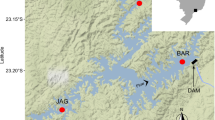Abstract
Weekly sampling over a two year period from a muddy sand bottom in the polyhaline York River, Virginia, U.S.A., clearly identified the pattern of recruitment and survival of the dominant annelid species. Three intermingled recruitment strategies and two survival patterns were observed, ranging from the classic opportunistic life style of mass recruitment over short time periods followed by mass mortality to prolonged recruitment with lower mortality. Qualitatively the annelid assemblage was very similar from year to year with most of the changes being quantitative. Oligochaetes, Tubificoides spp., were the most stable and characteristic members of the annelid assemblage.
Similar content being viewed by others
References
Boesch, D. F., 1973. Classification and community structure of macrobenthos in the Hampton Roads area, Virginia. Mar. Biol. 21: 226–244.
Boesch, D. F., 1977. Application of numerical classification in ecological investigations of water pollution. Ecol. Rec. Ser. EPA-600/3-77-033, 115 pp.
Boesch, D. F., M. L. Wass & R. W. Virnstein, 1976. The dynamics of estuarine benthic communities. In: Estuarine Processes, 1. Academic Press, N.Y.: 177–196.
Buchanan, J. B., P. F. Kingston & M. Sheader, 1974. Long term population trends of the benthic macrofauna in the offshore mud of the Northumberland Coast. J. mar. biol. Ass. U.K. 54: 785–795.
Buchanan, J. B., M. Sheader & P. F. Kingston, 1978. Sources of variability in the benthic macrofauna off the south Northumberland Coast, 1971–1976. J. mar. biol. Ass. U.K. 58: 191–209.
Eagle, R. A., 1975. Natural fluctuations in a soft bottom benthic community. J. mar. biol. Ass. U.K. 44: 864–878.
Gaugh, H. G. Jr., 1977. Ordiflex. Ecology and Systematics. Cornell University, Ithaca, N.Y. 185 pp.
Grassle, J. F. & J. P. Grassle, 1974. Opportunistic life histories and genetic systems in marine benthic populations. J. mar. Res. 32: 253–284.
Hull, C. H. & N. H. Nie, 1981. SPSS update 7.9. McGraw-Hill Publishing Co. Ltd, N. Y., 402 pp.
Mosteller, F. & J. W. Tukey, 1977. Data analysis and regression. Eddison-Wesley Publishing Co., Reading, Mass., 588 pp.
Nichols, F. H., 1975. Dynamics and energetics of three deposit-feeding benthic invertebrate populations in Puget and Washington. Ecol. Monogr. 45: 57–82.
Rhoads, D. C. & D. K. Young, 1970. The influence of deposit-feeding organisms on sediment stability and community trophic structure. J. mar. Res. 28: 150–178.
Virnstein, R. W., 1977. The importance of predation by crabs and fishes on benthic infauna in Chesapeake Bay. Ecology 58: 1199–1217.
Virnstein, R. W., 1979. Predation on estuarine infauna: response patterns of component species. Estuaries 2: 69–86.
Zaika, V. E., 1973. Specific production of aquatic invertebrates. J. Wiley & Sons, N.Y., 154 pp.
Author information
Authors and Affiliations
Additional information
Contribution No. 1118 of the Virginia Institute of Marine Science
Rights and permissions
About this article
Cite this article
Diaz, R.J. Short term dynamics of the dominant annelids in a polyhaline temperate estuary. Hydrobiologia 115, 153–158 (1984). https://doi.org/10.1007/BF00027910
Issue Date:
DOI: https://doi.org/10.1007/BF00027910




